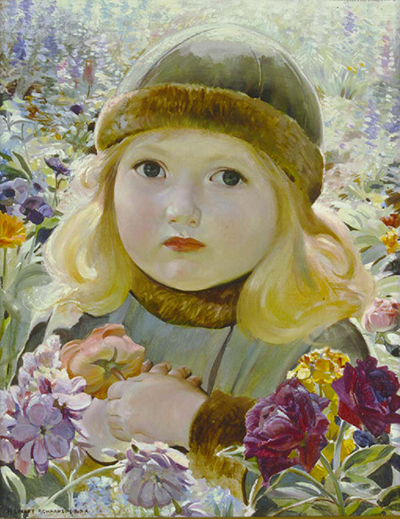Bloom – Floral Works from the Collection
Harry Richardson ‘Portrait of the Artist’s Daughter’ circa 1928, oil on canvas on board, 1943/4/1. Collection of the Sarjeant Gallery Te Whare o Rehua Whanganui. Gift of Mr T.D.H. Hall, Wellington, 1943
Bloom – Floral Works from the Collection
1 October – 6 November 2016

Megan Jenkinson ‘Evolution of the Species’ 1983, colour photograph, 1987/18/1. Collection of the Sarjeant Gallery Te Whare o Rehua Whanganui. Purchased, 1987
In celebration of the arrival of spring we are showing a selection of works from the Gallery’s permanent collection with a floral theme. Flowers have been present in artwork throughout history from the remains of fresco paintings found at Pompeii, the ancient Roman city covered in volcanic ash in 79 AD, through the Renaissance in the 15th century when flowers were used to illustrate mythological subjects, to one of our recent acquisitions Dead Hydrangea and Bunny, a lambda print by local artist Lynn Hurst.
The still life tradition, which relies heavily on floral subject matter, started as a result of the Protestant Reformation in the 16th century when traditional Catholic ornamentation and portraiture was stripped from churches and homes. Artists, looking for another source of commissions, began painting flowers and interiors, infusing them with symbolic meaning. Still life paintings often evoke death and the impermanence of life by showing the beauty of a flower in the process of dying as it wilts in a vase. A fine example of still life in this exhibition is the 17th century Flower Study attributed to Dutch painter Jan Baptiste.
The Arts & Crafts movement, which flourished in Europe 1880 – 1910, relied heavily on floral motifs as it sought to bring forms from nature into designs for interiors, as in Vivian Smith’s Untitled (Wallpaper Design). Flowers as a basis of design are also evident in Bloemetje, Bloemetje aan de wand by Bob Negryn, James Alp’s joyous painting Spring Thing, and Utagawa Kunisada’s 1861 Japanese woodblock print.
Flowers are often used as a form of expression when words do not suffice, such as at funerals and memorials. Anne Noble’s ethereal photograph Untitled (Study of Lilies) presents flowers as a focus for contemplation. This contrasts with works by artists such as Fiona Pardington who draws on the rich history of floral imagery to make the viewer feel uncomfortable with the presence of flowers in her work For the Price of Lilies (A portrait of Joseph Makea, 1985).
The vast array of floral works on display include the smallest painting in the collection – a miniature oil painting by Alfred Hayward, 19th century botanical drawings, an installation by Andrea Gardner composed of recycled meat trays, brooches by jeweller Warwick Freeman, and ceramic boxes with floral elements from the Rick Rudd Box collection. Celebrate the promise of spring with us as you move through this eclectic and varied exhibition. More information here…
Jennifer Taylor Moore, Curator of Collections
Date
18 June - 11 September 2016


